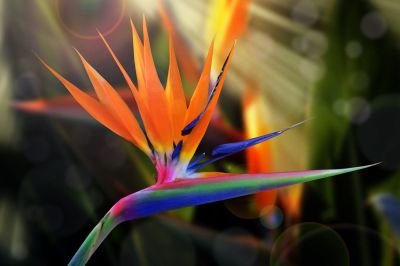The goals of bird of paradise pruning are to remove old plant matter, thin the leaves, and take out damaged stems. Bird of paradise (Strelitzia reginae) is one of those plants that you don’t forget. It’s not just their sheer size and impressive foliage but the plant’s namesake blooms. Near life-sized crane’s heads in bright, exotic plumage are the focal point of this extraordinary tropical plant. The flowers will last 2 to 3 weeks before dropping petals and dying. This is the first opportunity for pruning birds of paradise, but not the last.
How to Trim a Bird of Paradise
To my mind, trimming is different than pruning, and thinning is another thing altogether. Trimming is when you remove just a bit of the plant where it is damaged, dead, or diseased. You can trim a bird of paradise at any point since you are only removing a small amount of plant matter, so damage potential is minimal. Any time you cut into a plant you should have sharp implements, safety garb, and sanitized equipment to prevent introducing and spreading disease. Removing just damaged material to where it connects to the main body of the plant is how to trim a bird of paradise cleanly. This leaves no dead stems to mar the beauty of the plant. Retain any leaves with more than 50% live tissue.
How to Prune a Bird of Paradise
Bird of paradise pruning is a more serious affair. This is done for the same reasons as trimming, but the goals are more intensive and combined. You may wish to reduce the size of an older plant or remove leaves and stems that bar a pathway or window. This involves harder pruning and should be attacked in early spring. Use loppers, hand pruners or a pruning saw, but never hedge trimmers which will make rough cuts and leave ragged, damaged edges. Take all leaves and stems back to just above the ground. Remove dead flowers to the base of the plant and clean up any old vegetation that has dropped in or around the plant.
Pruning Birds of Paradise to Thin Overgrown Plants
Thinning is another way of cleaning up a bird of paradise. It allows air and light into the center of older plants, increasing flowering and reducing fungal disease. It is a crucial part of rejuvenating a neglected plant. Apply the trimming and pruning techniques and assess the effect. If the center of the plant is still too crowded, use long handled pruners and remove selected stems and leaves. Remove new growth at the base of the plant. You can divide it with a shovel and saw for replanting elsewhere. Never remove more than one third of plant material per season and follow up with good cultural care.
Pruning Other Types of Birds of Paradise
There are also desert-thriving bird of paradise plants found in another genus – red bird of paradise (Caesaepinia pulcherrima), yellow bird of paradise (C. gilliesii), and the Mexican bird of paradise (C. mexicana).
Red – Late winter to early spring (after threat of frost has ceased) is the best time to prune this type. Cut it back 6-12 inches (15-30 cm.) above the ground. It may need another trimming in midsummer, depending on its growth. Yellow – This should be done in late winter/early spring as well, but sparingly. Cut away any old blooms. If necessary, the branches can be cut back to half their length. Mexican – Again, like the others, pruning takes place in late winter or early spring. This one is similar to the yellow in that it is done sparingly. Cut away dry flower blooms and stalks at the bottom of the plant.
